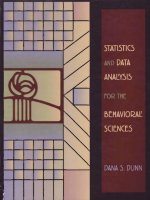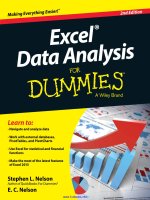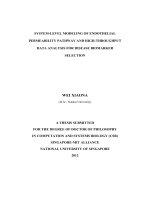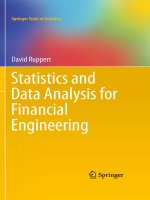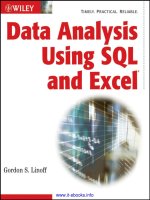Big data analysis for bioinformatics and biomedical discoveries
Bạn đang xem bản rút gọn của tài liệu. Xem và tải ngay bản đầy đủ của tài liệu tại đây (6.09 MB, 286 trang )
Big Data Analysis for
Bioinformatics and
Biomedical Discoveries
CHAPMAN & HALL/CRC
Mathematical and Computational Biology Series
Aims and scope:
This series aims to capture new developments and summarize what is known
over the entire spectrum of mathematical and computational biology and
medicine. It seeks to encourage the integration of mathematical, statistical,
and computational methods into biology by publishing a broad range of
textbooks, reference works, and handbooks. The titles included in the
series are meant to appeal to students, researchers, and professionals in the
mathematical, statistical and computational sciences, fundamental biology
and bioengineering, as well as interdisciplinary researchers involved in the
field. The inclusion of concrete examples and applications, and programming
techniques and examples, is highly encouraged.
Series Editors
N. F. Britton
Department of Mathematical Sciences
University of Bath
Xihong Lin
Department of Biostatistics
Harvard University
Nicola Mulder
University of Cape Town
South Africa
Maria Victoria Schneider
European Bioinformatics Institute
Mona Singh
Department of Computer Science
Princeton University
Anna Tramontano
Department of Physics
University of Rome La Sapienza
Proposals for the series should be submitted to one of the series editors above or directly to:
CRC Press, Taylor & Francis Group
3 Park Square, Milton Park
Abingdon, Oxfordshire OX14 4RN
UK
Published Titles
An Introduction to Systems Biology:
Design Principles of Biological Circuits
Uri Alon
Glycome Informatics: Methods and
Applications
Kiyoko F. Aoki-Kinoshita
Computational Systems Biology of
Cancer
Emmanuel Barillot, Laurence Calzone,
Philippe Hupé, Jean-Philippe Vert, and
Andrei Zinovyev
Python for Bioinformatics
Sebastian Bassi
Quantitative Biology: From Molecular to
Cellular Systems
Sebastian Bassi
Methods in Medical Informatics:
Fundamentals of Healthcare
Programming in Perl, Python, and Ruby
Jules J. Berman
Computational Biology: A Statistical
Mechanics Perspective
Ralf Blossey
Game-Theoretical Models in Biology
Mark Broom and Jan Rychtáˇr
Computational and Visualization
Techniques for Structural Bioinformatics
Using Chimera
Forbes J. Burkowski
Structural Bioinformatics: An Algorithmic
Approach
Forbes J. Burkowski
Normal Mode Analysis: Theory and
Applications to Biological and Chemical
Systems
Qiang Cui and Ivet Bahar
Kinetic Modelling in Systems Biology
Oleg Demin and Igor Goryanin
Data Analysis Tools for DNA Microarrays
Sorin Draghici
Statistics and Data Analysis for
Microarrays Using R and Bioconductor,
Second Edition
˘
Sorin Draghici
Computational Neuroscience:
A Comprehensive Approach
Jianfeng Feng
Biological Sequence Analysis Using
the SeqAn C++ Library
Andreas Gogol-Döring and Knut Reinert
Gene Expression Studies Using
Affymetrix Microarrays
Hinrich Göhlmann and Willem Talloen
Handbook of Hidden Markov Models
in Bioinformatics
Martin Gollery
Meta-analysis and Combining
Information in Genetics and Genomics
Rudy Guerra and Darlene R. Goldstein
Differential Equations and Mathematical
Biology, Second Edition
D.S. Jones, M.J. Plank, and B.D. Sleeman
Knowledge Discovery in Proteomics
Igor Jurisica and Dennis Wigle
Spatial Ecology
Stephen Cantrell, Chris Cosner, and
Shigui Ruan
Introduction to Proteins: Structure,
Function, and Motion
Amit Kessel and Nir Ben-Tal
Cell Mechanics: From Single ScaleBased Models to Multiscale Modeling
Arnaud Chauvière, Luigi Preziosi,
and Claude Verdier
RNA-seq Data Analysis: A Practical
Approach
Eija Korpelainen, Jarno Tuimala,
Panu Somervuo, Mikael Huss, and Garry Wong
Bayesian Phylogenetics: Methods,
Algorithms, and Applications
Ming-Hui Chen, Lynn Kuo, and Paul O. Lewis
Biological Computation
Ehud Lamm and Ron Unger
Statistical Methods for QTL Mapping
Zehua Chen
Optimal Control Applied to Biological
Models
Suzanne Lenhart and John T. Workman
Published Titles (continued)
Clustering in Bioinformatics and Drug
Discovery
John D. MacCuish and Norah E. MacCuish
Niche Modeling: Predictions from
Statistical Distributions
David Stockwell
Spatiotemporal Patterns in Ecology
and Epidemiology: Theory, Models,
and Simulation
Horst Malchow, Sergei V. Petrovskii, and
Ezio Venturino
Algorithms in Bioinformatics: A Practical
Introduction
Wing-Kin Sung
Stochastic Dynamics for Systems
Biology
Christian Mazza and Michel Benaïm
The Ten Most Wanted Solutions in
Protein Bioinformatics
Anna Tramontano
Engineering Genetic Circuits
Chris J. Myers
Combinatorial Pattern Matching
Algorithms in Computational Biology
Using Perl and R
Gabriel Valiente
Pattern Discovery in Bioinformatics:
Theory & Algorithms
Laxmi Parida
Exactly Solvable Models of Biological
Invasion
Sergei V. Petrovskii and Bai-Lian Li
Computational Hydrodynamics of
Capsules and Biological Cells
C. Pozrikidis
Modeling and Simulation of Capsules
and Biological Cells
C. Pozrikidis
Introduction to Bioinformatics
Anna Tramontano
Managing Your Biological Data with
Python
Allegra Via, Kristian Rother, and
Anna Tramontano
Cancer Systems Biology
Edwin Wang
Stochastic Modelling for Systems
Biology, Second Edition
Darren J. Wilkinson
Cancer Modelling and Simulation
Luigi Preziosi
Big Data Analysis for Bioinformatics and
Biomedical Discoveries
Shui Qing Ye
Introduction to Bio-Ontologies
Peter N. Robinson and Sebastian Bauer
Bioinformatics: A Practical Approach
Shui Qing Ye
Dynamics of Biological Systems
Michael Small
Introduction to Computational
Proteomics
Golan Yona
Genome Annotation
Jung Soh, Paul M.K. Gordon, and
Christoph W. Sensen
Big Data Analysis for
Bioinformatics and
Biomedical Discoveries
Edited by
Shui Qing Ye
MATLAB® is a trademark of The MathWorks, Inc. and is used with permission. The MathWorks does
not warrant the accuracy of the text or exercises in this book. This book’s use or discussion of MATLAB® software or related products does not constitute endorsement or sponsorship by The MathWorks
of a particular pedagogical approach or particular use of the MATLAB® software.
Cover Credit:
Foreground image: Zhang LQ, Adyshev DM, Singleton P, Li H, Cepeda J, Huang SY, Zou X, Verin AD,
Tu J, Garcia JG, Ye SQ. Interactions between PBEF and oxidative stress proteins - A potential new
mechanism underlying PBEF in the pathogenesis of acute lung injury. FEBS Lett. 2008; 582(13):1802-8
Background image: Simon B, Easley RB, Gregoryov D, Ma SF, Ye SQ, Lavoie T, Garcia JGN. Microarray
analysis of regional cellular responses to local mechanical stress in experimental acute lung injury. Am
J Physiol Lung Cell Mol Physiol. 2006; 291(5):L851-61
CRC Press
Taylor & Francis Group
6000 Broken Sound Parkway NW, Suite 300
Boca Raton, FL 33487-2742
© 2016 by Taylor & Francis Group, LLC
CRC Press is an imprint of Taylor & Francis Group, an Informa business
No claim to original U.S. Government works
Version Date: 20151228
International Standard Book Number-13: 978-1-4987-2454-8 (eBook - PDF)
This book contains information obtained from authentic and highly regarded sources. Reasonable
efforts have been made to publish reliable data and information, but the author and publisher cannot
assume responsibility for the validity of all materials or the consequences of their use. The authors and
publishers have attempted to trace the copyright holders of all material reproduced in this publication
and apologize to copyright holders if permission to publish in this form has not been obtained. If any
copyright material has not been acknowledged please write and let us know so we may rectify in any
future reprint.
Except as permitted under U.S. Copyright Law, no part of this book may be reprinted, reproduced,
transmitted, or utilized in any form by any electronic, mechanical, or other means, now known or
hereafter invented, including photocopying, microfilming, and recording, or in any information storage or retrieval system, without written permission from the publishers.
For permission to photocopy or use material electronically from this work, please access www.copyright.com ( or contact the Copyright Clearance Center, Inc. (CCC), 222
Rosewood Drive, Danvers, MA 01923, 978-750-8400. CCC is a not-for-profit organization that provides licenses and registration for a variety of users. For organizations that have been granted a photocopy license by the CCC, a separate system of payment has been arranged.
Trademark Notice: Product or corporate names may be trademarks or registered trademarks, and are
used only for identification and explanation without intent to infringe.
Visit the Taylor & Francis Web site at
and the CRC Press Web site at
Contents
Preface, ix
Acknowledgments, xiii
Editor, xv
Contributors, xvii
Section i
Commonly Used Tools for Big Data Analysis
chapter 1
◾
Linux for Big Data Analysis
3
Shui Qing Ye and ding-You Li
chapter 2
◾
Python for Big Data Analysis
15
dmitrY n. grigorYev
chapter 3
◾
R for Big Data Analysis
35
Stephen d. Simon
Section ii
Next-Generation DNA Sequencing Data Analysis
chapter 4
◾
Genome-Seq Data Analysis
57
min Xiong, Li Qin Zhang, and Shui Qing Ye
chapter 5
◾
RNA-Seq Data Analysis
79
Li Qin Zhang, min Xiong, danieL p. heruth, and Shui Qing Ye
chapter 6
◾
Microbiome-Seq Data Analysis
97
danieL p. heruth, min Xiong, and Xun Jiang
vii
viii ◾ Contents
chapter 7
miRNA-Seq Data Analysis
◾
117
danieL p. heruth, min Xiong, and guang-Liang Bi
chapter 8
Methylome-Seq Data Analysis
◾
131
chengpeng Bi
chapter 9
ChIP-Seq Data Analysis
◾
147
Shui Qing Ye, Li Qin Zhang, and Jiancheng tu
Section iii
Integrative and Comprehensive Big Data Analysis
chapter 10
◾
Integrating Omics Data in Big Data Analysis
163
Li Qin Zhang, danieL p. heruth, and Shui Qing Ye
chapter 11
◾
Pharmacogenetics and Genomics
179
andrea gaedigk, k atrin SangkuhL, and LariSa h. cavaLLari
chapter 12
◾
Exploring De-Identified Electronic Health
Record Data with i2b2
201
mark hoffman
chapter 13
◾
Big Data and Drug Discovery
215
geraLd J. WYckoff and d. andreW Skaff
chapter 14
◾
Literature-Based Knowledge Discovery
233
hongfang Liu and maJid r aStegar-moJarad
chapter 15
◾
Mitigating High Dimensionality in Big Data
Analysis
deendaYaL dinakarpandian
INDEX, 265
249
Preface
W
e are entering an era of Big Data. Big Data offer both unprecedented opportunities and overwhelming challenges. This book is
intended to provide biologists, biomedical scientists, bioinformaticians,
computer data analysts, and other interested readers with a pragmatic
blueprint to the nuts and bolts of Big Data so they more quickly, easily,
and effectively harness the power of Big Data in their ground-breaking
biological discoveries, translational medical researches, and personalized
genomic medicine.
Big Data refers to increasingly larger, more diverse, and more complex
data sets that challenge the abilities of traditionally or most commonly
used approaches to access, manage, and analyze data effectively. The monumental completion of human genome sequencing ignited the generation of
big biomedical data. With the advent of ever-evolving, cutting-edge, highthroughput omic technologies, we are facing an explosive growth in the
volume of biological and biomedical data. For example, Gene Expression
Omnibus ( holds 3,848 data sets of
transcriptome repositories derived from 1,423,663 samples, as of June 9,
2015. Big biomedical data come from government-sponsored projects
such as the 1000 Genomes Project ( international consortia such as the ENCODE Project ( />encode/), millions of individual investigator-initiated research projects,
and vast pharmaceutical R&D projects. Data management can become a
very complex process, especially when large volumes of data come from
multiple sources and diverse types, such as images, molecules, phenotypes,
and electronic medical records. These data need to be linked, connected,
and correlated, which will enable researchers to grasp the information that
is supposed to be conveyed by these data. It is evident that these Big Data
with high-volume, high-velocity, and high-variety information provide us
both tremendous opportunities and compelling challenges. By leveraging
ix
x ◾ Preface
the diversity of available molecular and clinical Big Data, biomedical scientists can now gain new unifying global biological insights into human
physiology and the molecular pathogenesis of various human diseases or
conditions at an unprecedented scale and speed; they can also identify
new potential candidate molecules that have a high probability of being
successfully developed into drugs that act on biological targets safely and
effectively. On the other hand, major challenges in using biomedical Big
Data are very real, such as how to have a knack for some Big Data analysis
software tools, how to analyze and interpret various next-generation DNA
sequencing data, and how to standardize and integrate various big biomedical data to make global, novel, objective, and data-driven discoveries.
Users of Big Data can be easily “lost in the sheer volume of numbers.”
The objective of this book is in part to contribute to the NIH Big Data to
Knowledge (BD2K) ( initiative and enable biomedical scientists to capitalize on the Big Data being generated in the omic
age; this goal may be accomplished by enhancing the computational and
quantitative skills of biomedical researchers and by increasing the number
of computationally and quantitatively skilled biomedical trainees.
This book covers many important topics of Big Data analyses in bioinformatics for biomedical discoveries. Section I introduces commonly used
tools and software for Big Data analyses, with chapters on Linux for Big
Data analysis, Python for Big Data analysis, and the R project for Big Data
computing. Section II focuses on next-generation DNA sequencing data
analyses, with chapters on whole-genome-seq data analysis, RNA-seq
data analysis, microbiome-seq data analysis, miRNA-seq data analysis,
methylome-seq data analysis, and ChIP-seq data analysis. Section III discusses comprehensive Big Data analyses of several major areas, with chapters on integrating omics data with Big Data analysis, pharmacogenetics
and genomics, exploring de-identified electronic health record data with
i2b2, Big Data and drug discovery, literature-based knowledge discovery,
and mitigating high dimensionality in Big Data analysis. All chapters in
this book are organized in a consistent and easily understandable format.
Each chapter begins with a theoretical introduction to the subject matter
of the chapter, which is followed by its exemplar applications and data
analysis principles, followed in turn by a step-by-step tutorial to help readers to obtain a good theoretical understanding and to master related practical applications. Experts in their respective fields have contributed to this
book, in common and plain English. Complex mathematical deductions
and jargon have been avoided or reduced to a minimum. Even a novice,
Preface ◾ xi
with little knowledge of computers, can learn Big Data analysis from this
book without difficulty. At the end of each chapter, several original and
authoritative references have been provided, so that more experienced
readers may explore the subject in depth. The intended readership of this
book comprises biologists and biomedical scientists; computer specialists
may find it helpful as well.
I hope this book will help readers demystify, humanize, and foster their
biomedical and biological Big Data analyses. I welcome constructive criticism and suggestions for improvement so that they may be incorporated
in a subsequent edition.
Shui Qing Ye
University of Missouri at Kansas City
MATLAB® is a registered trademark of The MathWorks, Inc. For product
information, please contact:
The MathWorks, Inc.
3 Apple Hill Drive
Natick, MA 01760-2098 USA
Tel: 508-647-7000
Fax: 508-647-7001
E-mail:
Web: www.mathworks.com
This page intentionally left blank
Acknowledgments
I
sincerely appreciate Dr. Sunil Nair, a visionary publisher from
CRC Press/Taylor & Francis Group, for granting us the opportunity to
contribute this book. I also thank Jill J. Jurgensen, senior project coordinator; Alex Edwards, editorial assistant; and Todd Perry, project editor, for
their helpful guidance, genial support, and patient nudge along the way of
our writing and publishing process.
I thank all contributing authors for committing their precious time and
efforts to pen their valuable chapters and for their gracious tolerance to
my haggling over revisions and deadlines. I am particularly grateful to my
colleagues, Dr. Daniel P. Heruth and Dr. Min Xiong, who have not only
contributed several chapters but also carefully double checked all nextgeneration DNA sequencing data analysis pipelines and other tutorial
steps presented in the tutorial sections of all chapters.
Finally, I am deeply indebted to my wife, Li Qin Zhang, for standing
beside me throughout my career and editing this book. She has not only
contributed chapters to this book but also shouldered most responsibilities of gourmet cooking, cleaning, washing, and various household chores
while I have been working and writing on weekends, nights, and other
times inconvenient to my family. I have also relished the understanding,
support, and encouragement of my lovely daughter, Yu Min Ye, who is also
a writer, during this endeavor.
xiii
This page intentionally left blank
Editor
Shui Qing Ye, MD, PhD, is the William R. Brown/Missouri endowed chair
in medical genetics and molecular medicine and a tenured full professor
in biomedical and health informatics and pediatrics at the University of
Missouri–Kansas City, Missouri. He is also the director in the Division of
Experimental and Translational Genetics, Department of Pediatrics, and
director in the Core of Omic Research at The Children’s Mercy Hospital.
Dr. Ye completed his medical education from Wuhan University School
of Medicine, Wuhan, China, and earned his PhD from the University of
Chicago Pritzker School of Medicine, Chicago, Illinois. Dr. Ye’s academic
career has evolved from an assistant professorship at Johns Hopkins
University, Baltimore, Maryland, followed by an associate professorship at
the University of Chicago to a tenured full professorship at the University
of Missouri at Columbia and his current positions.
Dr. Ye has been engaged in biomedical research for more than 30 years;
he has experience as a principal investigator in the NIH-funded RO1 or
pharmaceutical company–sponsored research projects as well as a coinvestigator in the NIH-funded RO1, Specialized Centers of Clinically
Oriented Research (SCCOR), Program Project Grant (PPG), and private
foundation fundings. He has served in grant review panels or study sections
of the National Heart, Lung, Blood Institute (NHLBI)/National Institutes of Health (NIH), Department of Defense, and American Heart
Association. He is currently a member in the American Association for
the Advancement of Science, American Heart Association, and American
Thoracic Society. Dr. Ye has published more than 170 peer-reviewed
research articles, abstracts, reviews, book chapters, and he has participated in the peer review activity for a number of scientific journals.
Dr. Ye is keen on applying high-throughput genomic and transcriptomic approaches, or Big Data, in his biomedical research. Using direct
DNA sequencing to identify single-nucleotide polymorphisms in patient
xv
xvi ◾ Editor
DNA samples, his lab was the first to report a susceptible haplotype and
a protective haplotype in the human pre-B-cell colony-enhancing factor
gene promoter to be associated with acute respiratory distress syndrome.
Through a DNA microarray to detect differentially expressed genes,
Dr. Ye’s lab discovered that the pre-B-cell colony-enhancing factor gene
was highly upregulated as a biomarker in acute respiratory distress syndrome. Dr. Ye had previously served as the director, Gene Expression
Profiling Core, at the Center of Translational Respiratory Medicine in
Johns Hopkins University School of Medicine and the director, Molecular
Resource Core, in an NIH-funded Program Project Grant on Lung
Endothelial Pathobiology at the University of Chicago Pritzker School
of Medicine. He is currently directing the Core of Omic Research at The
Children’s Mercy Hospital, University of Missouri–Kansas City, which
has conducted exome-seq, RNA-seq, miRNA-seq, and microbiome-seq
using state-of-the-art next-generation DNA sequencing technologies. The
Core is continuously expanding its scope of service on omic research. Dr.
Ye, as the editor, has published a book entitled Bioinformatics: A Practical
Approach (CRC Press/Taylor & Francis Group, New York). One of Dr. Ye’s
current and growing research interests is the application of translational
bioinformatics to leverage Big Data to make biological discoveries and
gain new unifying global biological insights, which may lead to the development of new diagnostic and therapeutic targets for human diseases.
Contributors
Chengpeng Bi
Division of Clinical Pharmacology,
Toxicology, and Therapeutic
Innovations
The Children’s Mercy Hospital
University of Missouri-Kansas
City School of Medicine
Kansas City, Missouri
Guang-Liang Bi
Department of Neonatology
Nanfang Hospital, Southern
Medical University
Guangzhou, China
Larisa H. Cavallari
Department of Pharmacotherapy
and Translational Research
Center for Pharmacogenomics
University of Florida
Gainesville, Florida
Deendayal Dinakarpandian
Department of Computer
Science and Electrical
Engineering
University of Missouri-Kansas
City School of Computing and
Engineering
Kansas City, Missouri
Andrea Gaedigk
Division of Clinical Pharmacology,
Toxicology & Therapeutic
Innovation
Children’s Mercy Kansas City
and
Department of Pediatrics
University of Missouri-Kansas
City School of Medicine
Kansas City, Missouri
Dmitry N. Grigoryev
Laboratory of Translational
Studies and Personalized
Medicine
Moscow Institute of Physics and
Technology
Dolgoprudny, Moscow, Russia
Daniel P. Heruth
Division of Experimental and
Translational Genetics
Children’s Mercy Hospitals and
Clinics
and
University of Missouri-Kansas
City School of Medicine
Kansas City, Missouri
xvii
xviii ◾ Contributors
Mark Hoffman
Department of Biomedical
and Health Informatics and
Department of Pediatrics
Center for Health Insights
University of Missouri-Kansas
City School of Medicine
Kansas City, Missouri
Xun Jiang
Department of Pediatrics, Tangdu
Hospital
The Fourth Military Medical
University
Xi’an, Shaanxi, China
Ding-You Li
Division of Gastroenterology
Children’s Mercy Hospitals and
Clinics
and
University of Missouri-Kansas
City School of Medicine
Kansas City, Missouri
Hongfang Liu
Biomedical Statistics and
Informatics
Mayo Clinic
Rochester, Minnesota
Majid Rastegar-Mojarad
Biomedical Statistics and
Informatics
Mayo Clinic
Rochester, Minnesota
Katrin Sangkuhl
Department of Genetics
Stanford University
Stanford, California
Stephen D. Simon
Department of Biomedical
and Health Informatics
University of MissouriKansas City School of Medicine
Kansas City, Missouri
D. Andrew Skaff
Division of Molecular Biology and
Biochemistry
University of Missouri-Kansas
City School of Biological
Sciences
Kansas City, Missouri
Jiancheng Tu
Department of Clinical
Laboratory Medicine
Zhongnan Hospital
Wuhan University School of
Medicine
Wuhan, China
Gerald J. Wyckoff
Division of Molecular Biology
and Biochemistry
University of Missouri-Kansas
City School of Biological
Sciences
Kansas City, Missouri
Contributors ◾ xix
Min Xiong
Division of Experimental and
Translational Genetics
Children’s Mercy Hospitals and
Clinics
and
University of Missouri-Kansas
City School of Medicine
Kansas City, Missouri
Li Qin Zhang
Division of Experimental and
Translational Genetics
Children’s Mercy Hospitals and
Clinics
and
University of Missouri-Kansas
City School of Medicine
Kansas City, Missouri
This page intentionally left blank
I
Commonly Used Tools
for Big Data Analysis
1
This page intentionally left blank
Chapter
1
Linux for Big
Data Analysis
Shui Qing Ye and Ding-you Li
CONTENTS
1.1 Introduction
1.2 Running Basic Linux Commands
1.2.1 Remote Login to Linux Using Secure Shell
1.2.2 Basic Linux Commands
1.2.3 File Access Permission
1.2.4 Linux Text Editors
1.2.5 Keyboard Shortcuts
1.2.6 Write Shell Scripts
1.3 Step-By-Step Tutorial on Next-Generation Sequence Data
Analysis by Running Basic Linux Commands
1.3.1 Step 1: Retrieving a Sequencing File
1.3.1.1 Locate the File
1.3.1.2 Downloading the Short-Read Sequencing File
(SRR805877) from NIH GEO Site
1.3.1.3 Using the SRA Toolkit to Convert .sra Files
into .fastq Files
1.3.2 Step 2: Quality Control of Sequences
1.3.2.1 Make a New Directory “Fastqc”
1.3.2.2 Run “Fastqc”
1.3.3 Step 3: Mapping Reads to a Reference Genome
1.3.3.1 Downloading the Human Genome and
Annotation from Illumina iGenomes
1.3.3.2 Decompressing .tar.gz Files
4
6
6
6
8
8
9
9
11
11
12
12
12
12
12
13
13
13
13
3
4 ◾ Big Data Analysis for Bioinformatics and Biomedical Discoveries
1.3.3.3 Link Human Annotation and Bowtie Index
to the Current Working Directory
1.3.3.4 Mapping Reads into Reference Genome
1.3.4 Step 4: Visualizing Data in a Genome Browser
1.3.4.1 Go to Human (Homo sapiens) Genome
Browser Gateway
1.3.4.2 Visualize the File
Bibliography
13
13
14
14
14
14
1.1 INTRODUCTION
As biological data sets have grown larger and biological problems have
become more complex, the requirements for computing power have also
grown. Computers that can provide this power generally use the Linux/
Unix operating system. Linux was developed by Linus Benedict Torvalds
when he was a student in the University of Helsinki, Finland, in early
1990s. Linux is a modular Unix-like computer operating system assembled
under the model of free and open-source software development and distribution. It is the leading operating system on servers and other big iron systems such as mainframe computers and supercomputers. Compared to
the Windows operating system, Linux has the following advantages:
1. Low cost: You don’t need to spend time and money to obtain licenses
since Linux and much of its software come with the GNU General
Public License. GNU is a recursive acronym for GNU’s Not Unix!.
Additionally, there are large software repositories from which you
can freely download for almost any task you can think of.
2. Stability: Linux doesn’t need to be rebooted periodically to maintain
performance levels. It doesn’t freeze up or slow down over time due
to memory leaks. Continuous uptime of hundreds of days (up to a
year or more) are not uncommon.
3. Performance: Linux provides persistent high performance on workstations and on networks. It can handle unusually large numbers
of users simultaneously and can make old computers sufficiently
responsive to be useful again.
4. Network friendliness: Linux has been continuously developed by a
group of programmers over the Internet and has therefore strong

